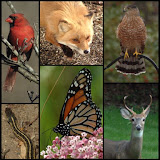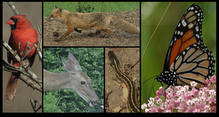2007 Great Backyard Bird Count Results for the Colvin Run Habitat
Here is a re-cap of the results from the 2007 Great Backyard Bird Count here at the Colvin Run Habitat. Let’s begin with a few antidotes:
>In each of the three 15-minute counts, at least one hawk was present; in two of the counts, two hawks were present.
>A pair of never before observed yellow-bellied sapsuckers was observed.
>A pileated woodpecker was observed from his call.
>A well-formed V of Canadian geese fly over during one of the 15-minute periods.
>The Habitat experienced a snow shower during the third period that left nearly an inch of additional snow on the ground.
>Bird totals for the three 15-minute periods were 103, 64, and 99, respectively.
>Nine white-tailed deer wondered through during the first day; they were not included in the submitted count.
The conditions were:
>Weather: excellent
>Snow Depth: 2 - 4 in (5.1 - 10.2 cm)
>Habitat(s): deciduous woods, grassland, suburban
Here are the links to the Colvin Run Habitat blog posts discussing the 2007 Great Backyard Bird Count:
>Cooper's Hawk, Red-Tailed, and Red-Shouldered Hawk All Appear for the Count
>Cooper’s Hawk and Red-Shouldered Hawk Arrive to be Counted Again
>2007 Great Backyard Bird Count Continues at the Colvin Run Habitat
>Yellow-bellied Sapsucker Arrives for First Time
>Nine White-Tailed Deer Show for the Count
Below are the three 15-minute counts submitted to the 2007 Great Backyard Bird Count from the Colvin Run Habitat:
| Species | Feb 17, 2007 9:00 AM | Feb 17, 2007 11:30 AM | Feb 18, 2007 5:45 PM |
| American Crow | 6 | | |
| American Goldfinch | 2 | | |
| Blue Jay | 1 | 1 | |
| Canada Goose | | | 15 |
| | 6 | 3 | 7 |
| | 10 | 4 | 4 |
| Cooper's Hawk | 1 | | 1 |
| Dark-eyed Junco | 15 | 6 | 5 |
| Downy Woodpecker | 2 | 2 | 6 |
| Eastern Starling | 12 | 4 | |
| Eastern Towhee | 2 | 1 | |
| House Finch | 6 | 4 | |
| Morning Dove | | 2 | |
| Northern Cardinal | | 7 | 47 |
| Northern Mockingbird | | 1 | |
| Pileated Woodpecker | 1 | | |
| Red-bellied Woodpecker | | | 1 |
| Red-shouldered Hawk | | 1 | 1 |
| Red-tailed Hawk | | 1 | |
| Tufted Titmouse | 12 | 8 | 8 |
| White-breasted Nuthatch | 1 | 1 | |
| White-throated Sparrow | 24 | 18 | 4 |
| Yellow-bellied Sapsucker | 2 | | |
| White-tailed Deer | | 9 | |










